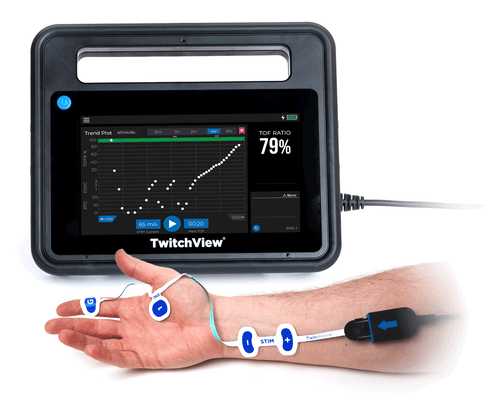EMG vs. Subjective Monitoring: What the Data Tells Us

Why This Matters
Every anesthesiologist is trained to assess recovery—but how they do it can make or break a patient’s outcome.
Historically, many clinicians have relied on subjective methods like visual or tactile assessment of twitch response to determine when and how to reverse neuromuscular blockade and extubate. While that approach was once considered standard, a growing body of research shows it simply isn’t enough.
Electromyography (EMG) is now recognized as a more accurate, reproducible, and clinically validated method of neuromuscular monitoring.
In this article, we’ll break down:
- The clinical difference between EMG and subjective monitoring
- What the latest studies say about residual paralysis
- Why moving to objective, EMG-based systems matters for safety, efficiency, and outcomes
The Problem with Subjective Twitch Monitoring
Visual and tactile assessments are common—but subjective. They rely on human perception, which is inconsistent across users and environments. This includes techniques like:
- Feeling for a thumb twitch (tactile)
- Watching for visual muscle movement
- Assessing fade without quantifying TOF ratio
The challenge?
Subjective methods often overestimate recovery. Clinicians may interpret fade as absent, when in fact, neuromuscular function hasn’t fully returned.
A landmark study published in Anesthesiology found that nearly 40% of patients monitored with subjective assessments experienced residual paralysis at extubation (defined as TOF ratio <0.9).
Residual paralysis isn’t a benign complication. It increases the risk of:
- Hypoxia
- Upper airway obstruction
- Delayed emergence
- Unplanned ICU admission
- Reintubation
These aren’t edge cases—they’re daily risks. And they’re largely avoidable.
What Makes EMG Different
Electromyography (EMG) measures the actual electrical signal in the muscle in response to nerve stimulation. It does not rely on movement or visual cues—it captures real-time, physiological response.
Compared to acceleromyography (AMG) or kinemyography (KMG), which monitor motion via sensors, EMG measures what truly matters: direct muscle activation.
This offers a critical benefit:
- Consistent, reproducible data—regardless of patient positioning, arm tucked, robotic cases, or signal noise.
- Reliable measurement of TOF ratio >0.9 before extubation
- Clear visibility into trends and pharmacokinetics of NMBA and reversal agents
What the Data Tells Us
Here’s what peer-reviewed research and ASA-aligned guidance confirm:
- Acceleromyography (AMG) overestimates recovery and all quantitative monitors need to be validated against gold standard mechanomyography.
Quantitative monitoring—especially electromyography (EMG)—is emphasized over acceleromyography (AMG) due to superior clinical utility. Unlike AMG, EMG does not require thumb movement and does not overestimate the Train-of-Four (TOF) ratio, making it both more accurate and more practical in modern operating rooms. EMG monitors like the TwitchView monitor closely match the gold-standard mechanomyography in performance, whereas some EMG systems may misinterpret electrical noise as twitch activity if not properly validated.
Wolfgang K, Clemens Dr. “Electromyography vs. Acceleromyography.” Anesthesia Experts, Sept 2024 - The efficacy of reversal agents needs to be monitored.
Researchers investigated the appropriate dosing of sugammadex for reversing rocuronium-induced neuromuscular blockade. They found that 13% of patients required a dose higher than the manufacturer’s recommended dose to reach complete recovery, as confirmed by TwitchView quantitative monitoring. These results underscore the limitations of one-size-fits-all dosing and highlight the importance of individualized reversal strategies. The authors conclude that tailoring sugammadex dosing based on real-time, objective monitoring—rather than relying solely on fixed dosing or subjective assessments—is essential for ensuring complete and safe recovery from neuromuscular blockade.
A Dose‑Finding Study of Sugammadex for Reversal of Rocuronium in Cardiac Surgery Patients and Postoperative Monitoring for Recurrent Paralysis - Reversal agents alone don’t guarantee recovery.
Even with agents like sugammadex, the ASA warns that residual neuromuscular blockade can persist. Quantitative monitoring remains the gold standard to confirm full recovery (TOF ratio ≥ 0.9).
ASA Practice Guidelines: Monitoring and Antagonism of Neuromuscular Blockade, Jan 2025 - In controlled OR settings, EMG can eliminate residual paralysis.
In a 2023 U.S. prospective cohort study of 189 patients, quantitative TwitchView EMG monitoring was used to guide rocuronium dosing and selective reversal with either neostigmine or sugammadex. When best practices were followed—including no reversal agent bypassing and appropriate timing—0% of patients experienced residual neuromuscular blockade (TOF ratio < 0.9). This data reinforces that when implemented correctly, EMG-based monitoring protocols can virtually eliminate residual paralysis in real-world surgical settings.
Thilen et al., Anesth Analg. 2024;139(3):536–544.
Why This Impacts Workflow, Not Just Safety
Beyond patient outcomes, EMG also improves team efficiency:
- Shorter PACU times due to more effective reversal
- Targeted use of relaxants and reversal agents, leading to lower pharmacy costs
- Improved case turnover by eliminating recovery delays
It also gives anesthesiologists something less measurable—but equally critical:
Confidence.
When you can trust your monitor, you can focus on the patient—not second-guess the data.
What the ASA Recommends
In 2023, the American Society of Anesthesiologists (ASA) released updated guidelines that explicitly recommend quantitative neuromuscular monitoring, when non-depolarizing muscle relaxants are used.
This marks a turning point. Subjective assessments are no longer enough. Hospitals that fail to adapt may fall behind in both clinical practice and patient safety standards.
When You Know Better, You Do Better
We’re not here to create unnecessary complexity. EMG doesn’t make anesthesia harder—it makes decision-making quantitative and simply put, easier.
It gives you a signal you can rely on in every OR, for every case.
- No drift.
- No calibration.
- No guesswork.
Just accurate, actionable data.
Residual Paralysis is Preventable
There’s a growing consensus: residual paralysis is preventable, and subjective assessments aren’t good enough.
Clinicians deserve better tools—and patients deserve safer outcomes.
The TwitchView TOF Monitor is your tool - an EMG-based quantitative twitch monitor that was designed to bring consistent, objective neuromuscular monitoring to everyday anesthesia practice and support a safe recovery for every patient. TwitchView is helping anesthesiologists close the gap between assumption and certainty.
In the final minutes of a case, trust in your monitor shouldn’t be optional.



